Professional Project: Absenteeism and Absence Management in Healthcare
VerifiedAdded on 2020/05/16
|29
|6047
|76
Project
AI Summary
This professional project examines employee absenteeism and its impact on absence management within the healthcare industry, primarily focusing on the Australian context. The study explores the background of absenteeism, its consequences on service quality, and formulates research questions to guide the investigation. A comprehensive literature review delves into the causes of absenteeism, challenges faced by absence management, and the role of managers in mitigating absences. The research employs a descriptive design, relying on secondary data from sources like articles, journals, and healthcare reports. Data analysis includes thematic analysis to identify key themes and patterns. The findings address the research questions, highlighting the factors influencing absenteeism and the effectiveness of managerial interventions. The conclusion summarizes the project's key insights, acknowledges limitations, and provides recommendations for improving absence management practices in the healthcare sector. The project aims to understand the complex relationship between absenteeism and healthcare service delivery, offering valuable insights for healthcare organizations to enhance their operational efficiency and patient care.
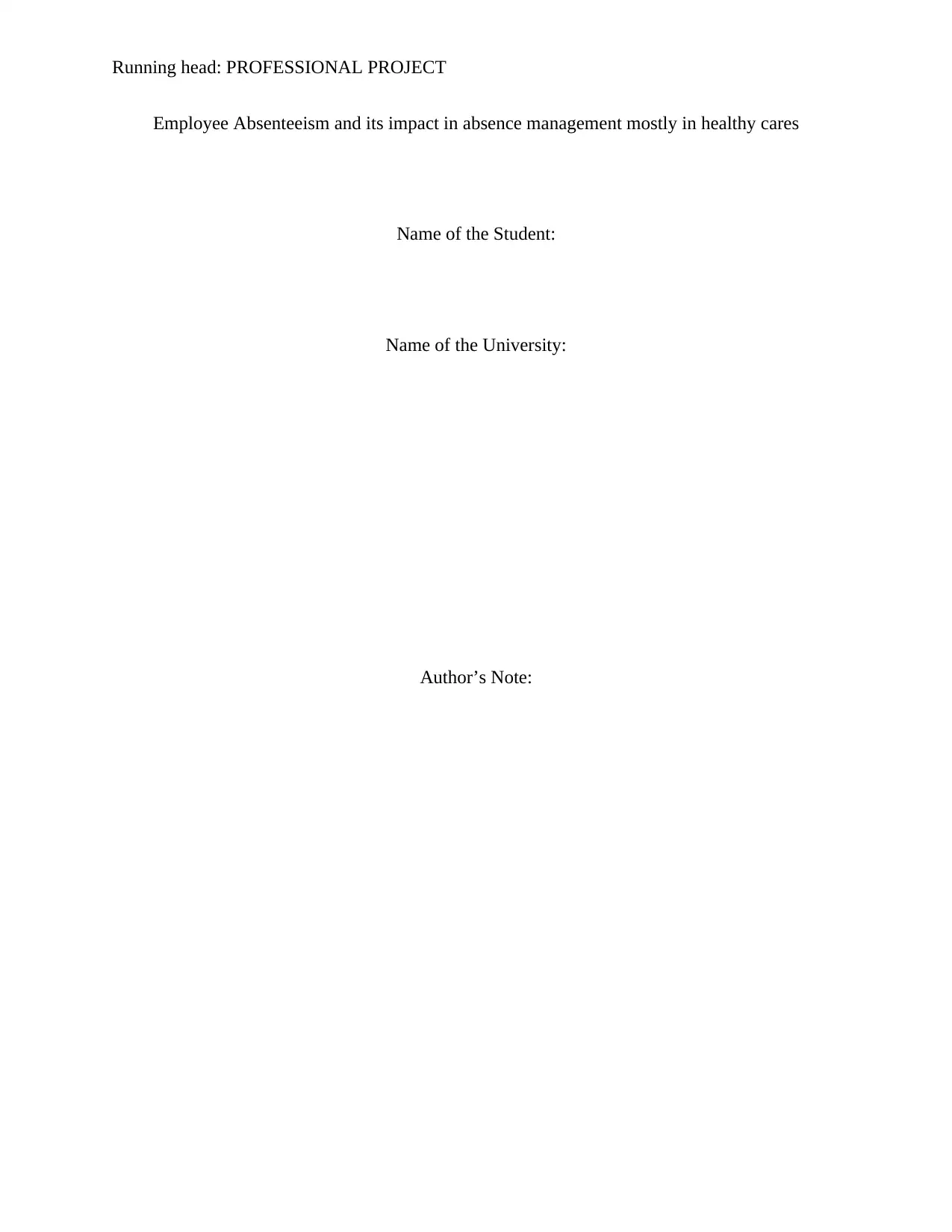
Running head: PROFESSIONAL PROJECT
Employee Absenteeism and its impact in absence management mostly in healthy cares
Name of the Student:
Name of the University:
Author’s Note:
Employee Absenteeism and its impact in absence management mostly in healthy cares
Name of the Student:
Name of the University:
Author’s Note:
Paraphrase This Document
Need a fresh take? Get an instant paraphrase of this document with our AI Paraphraser
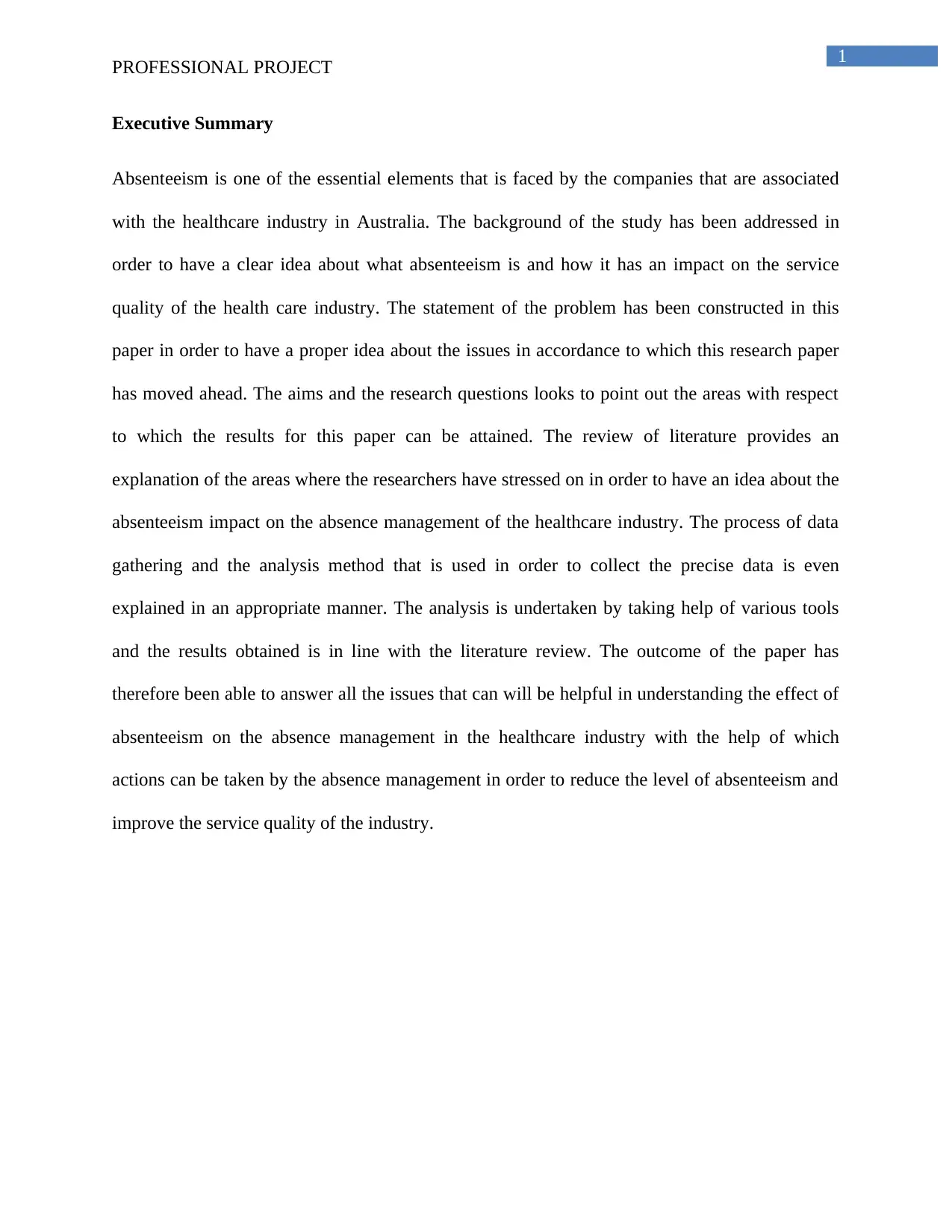
1
PROFESSIONAL PROJECT
Executive Summary
Absenteeism is one of the essential elements that is faced by the companies that are associated
with the healthcare industry in Australia. The background of the study has been addressed in
order to have a clear idea about what absenteeism is and how it has an impact on the service
quality of the health care industry. The statement of the problem has been constructed in this
paper in order to have a proper idea about the issues in accordance to which this research paper
has moved ahead. The aims and the research questions looks to point out the areas with respect
to which the results for this paper can be attained. The review of literature provides an
explanation of the areas where the researchers have stressed on in order to have an idea about the
absenteeism impact on the absence management of the healthcare industry. The process of data
gathering and the analysis method that is used in order to collect the precise data is even
explained in an appropriate manner. The analysis is undertaken by taking help of various tools
and the results obtained is in line with the literature review. The outcome of the paper has
therefore been able to answer all the issues that can will be helpful in understanding the effect of
absenteeism on the absence management in the healthcare industry with the help of which
actions can be taken by the absence management in order to reduce the level of absenteeism and
improve the service quality of the industry.
PROFESSIONAL PROJECT
Executive Summary
Absenteeism is one of the essential elements that is faced by the companies that are associated
with the healthcare industry in Australia. The background of the study has been addressed in
order to have a clear idea about what absenteeism is and how it has an impact on the service
quality of the health care industry. The statement of the problem has been constructed in this
paper in order to have a proper idea about the issues in accordance to which this research paper
has moved ahead. The aims and the research questions looks to point out the areas with respect
to which the results for this paper can be attained. The review of literature provides an
explanation of the areas where the researchers have stressed on in order to have an idea about the
absenteeism impact on the absence management of the healthcare industry. The process of data
gathering and the analysis method that is used in order to collect the precise data is even
explained in an appropriate manner. The analysis is undertaken by taking help of various tools
and the results obtained is in line with the literature review. The outcome of the paper has
therefore been able to answer all the issues that can will be helpful in understanding the effect of
absenteeism on the absence management in the healthcare industry with the help of which
actions can be taken by the absence management in order to reduce the level of absenteeism and
improve the service quality of the industry.
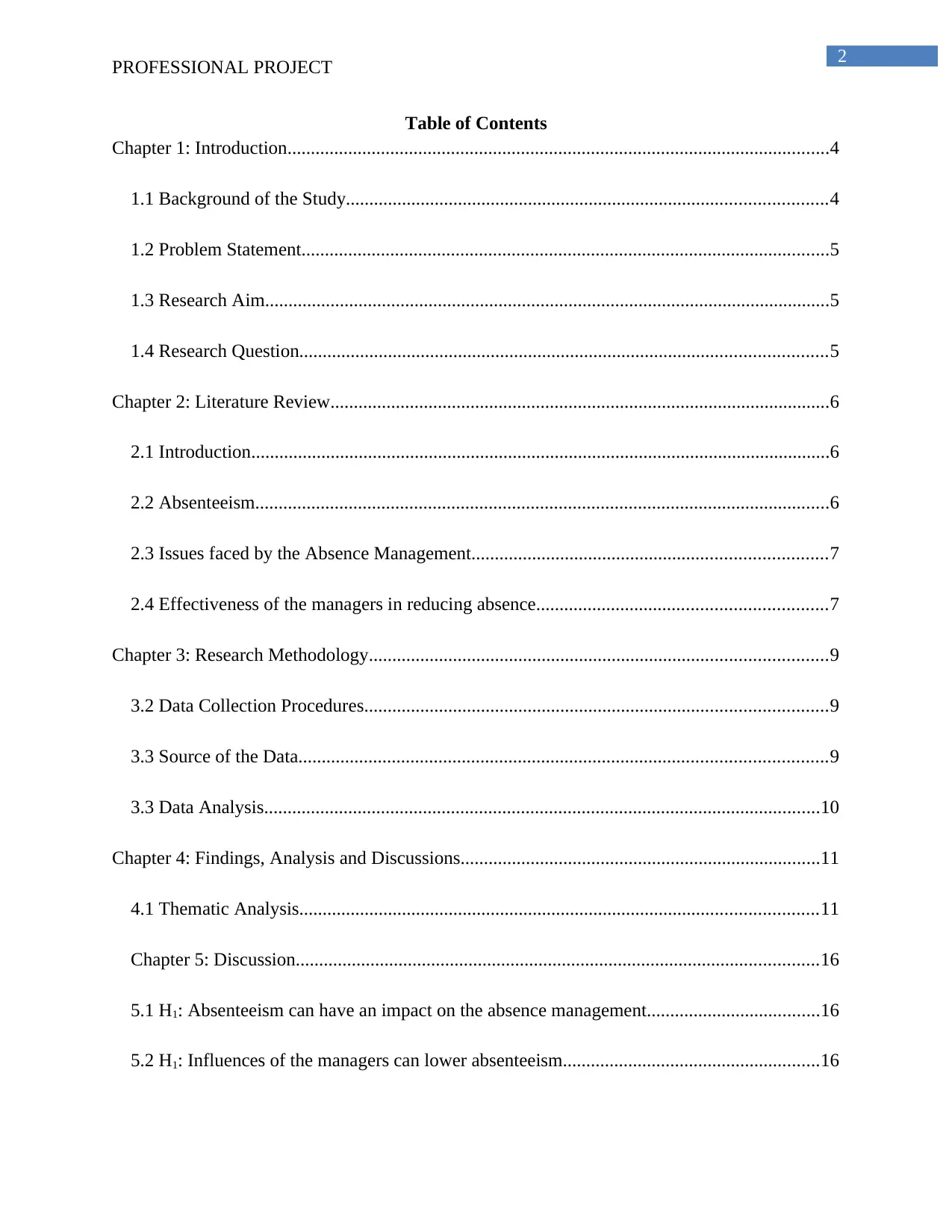
2
PROFESSIONAL PROJECT
Table of Contents
Chapter 1: Introduction....................................................................................................................4
1.1 Background of the Study.......................................................................................................4
1.2 Problem Statement.................................................................................................................5
1.3 Research Aim.........................................................................................................................5
1.4 Research Question.................................................................................................................5
Chapter 2: Literature Review...........................................................................................................6
2.1 Introduction............................................................................................................................6
2.2 Absenteeism...........................................................................................................................6
2.3 Issues faced by the Absence Management............................................................................7
2.4 Effectiveness of the managers in reducing absence..............................................................7
Chapter 3: Research Methodology..................................................................................................9
3.2 Data Collection Procedures...................................................................................................9
3.3 Source of the Data.................................................................................................................9
3.3 Data Analysis.......................................................................................................................10
Chapter 4: Findings, Analysis and Discussions.............................................................................11
4.1 Thematic Analysis...............................................................................................................11
Chapter 5: Discussion................................................................................................................16
5.1 H1: Absenteeism can have an impact on the absence management.....................................16
5.2 H1: Influences of the managers can lower absenteeism.......................................................16
PROFESSIONAL PROJECT
Table of Contents
Chapter 1: Introduction....................................................................................................................4
1.1 Background of the Study.......................................................................................................4
1.2 Problem Statement.................................................................................................................5
1.3 Research Aim.........................................................................................................................5
1.4 Research Question.................................................................................................................5
Chapter 2: Literature Review...........................................................................................................6
2.1 Introduction............................................................................................................................6
2.2 Absenteeism...........................................................................................................................6
2.3 Issues faced by the Absence Management............................................................................7
2.4 Effectiveness of the managers in reducing absence..............................................................7
Chapter 3: Research Methodology..................................................................................................9
3.2 Data Collection Procedures...................................................................................................9
3.3 Source of the Data.................................................................................................................9
3.3 Data Analysis.......................................................................................................................10
Chapter 4: Findings, Analysis and Discussions.............................................................................11
4.1 Thematic Analysis...............................................................................................................11
Chapter 5: Discussion................................................................................................................16
5.1 H1: Absenteeism can have an impact on the absence management.....................................16
5.2 H1: Influences of the managers can lower absenteeism.......................................................16
⊘ This is a preview!⊘
Do you want full access?
Subscribe today to unlock all pages.

Trusted by 1+ million students worldwide
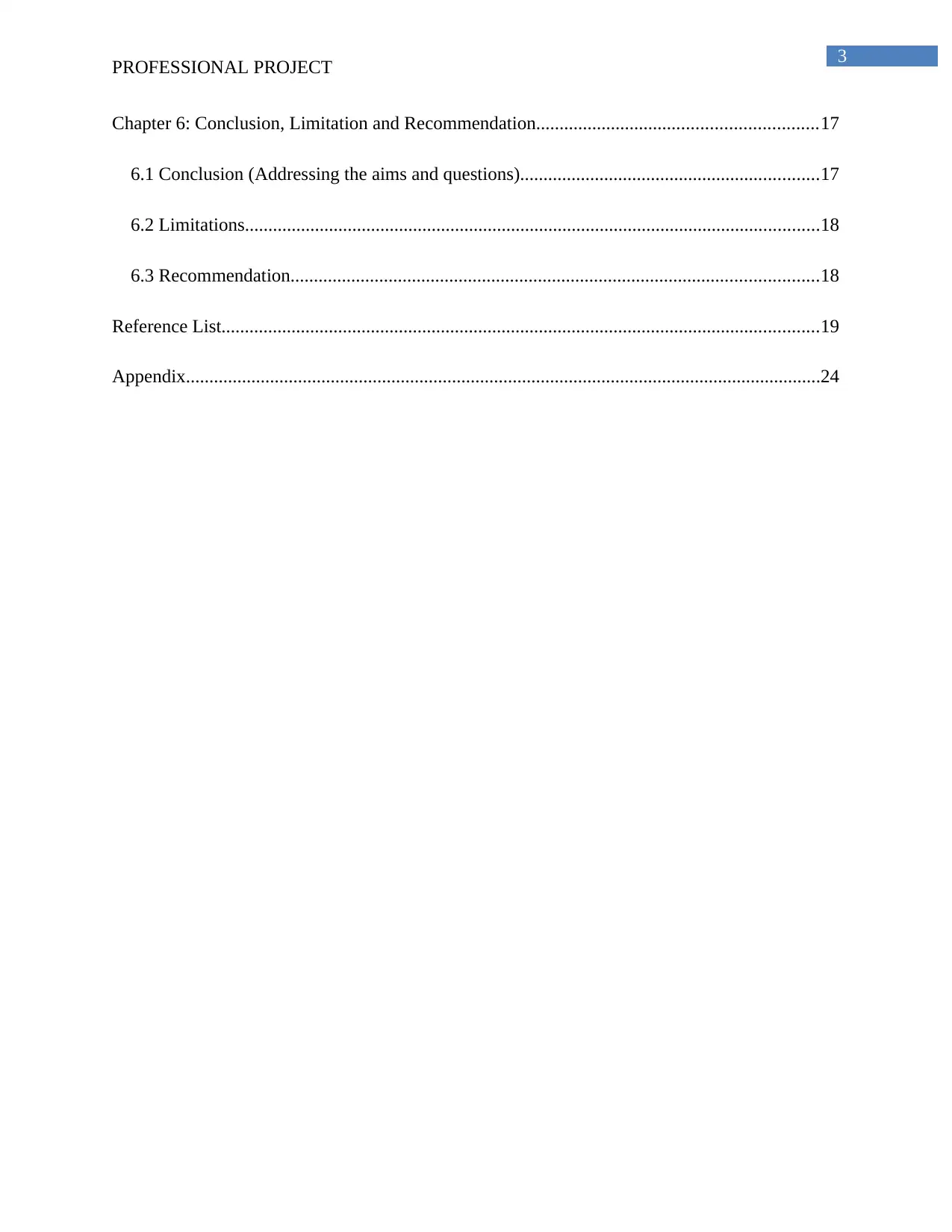
3
PROFESSIONAL PROJECT
Chapter 6: Conclusion, Limitation and Recommendation............................................................17
6.1 Conclusion (Addressing the aims and questions)................................................................17
6.2 Limitations...........................................................................................................................18
6.3 Recommendation.................................................................................................................18
Reference List................................................................................................................................19
Appendix........................................................................................................................................24
PROFESSIONAL PROJECT
Chapter 6: Conclusion, Limitation and Recommendation............................................................17
6.1 Conclusion (Addressing the aims and questions)................................................................17
6.2 Limitations...........................................................................................................................18
6.3 Recommendation.................................................................................................................18
Reference List................................................................................................................................19
Appendix........................................................................................................................................24
Paraphrase This Document
Need a fresh take? Get an instant paraphrase of this document with our AI Paraphraser
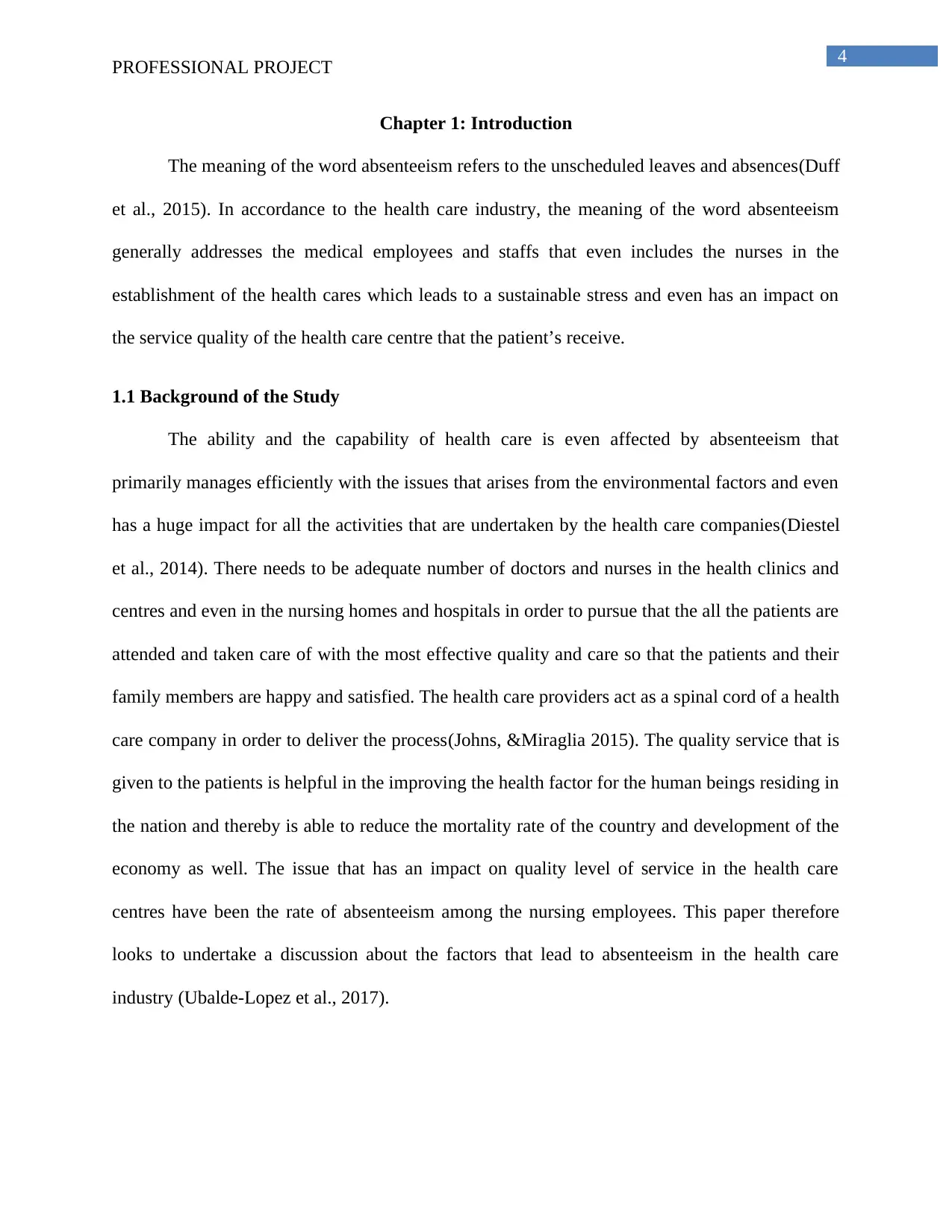
4
PROFESSIONAL PROJECT
Chapter 1: Introduction
The meaning of the word absenteeism refers to the unscheduled leaves and absences(Duff
et al., 2015). In accordance to the health care industry, the meaning of the word absenteeism
generally addresses the medical employees and staffs that even includes the nurses in the
establishment of the health cares which leads to a sustainable stress and even has an impact on
the service quality of the health care centre that the patient’s receive.
1.1 Background of the Study
The ability and the capability of health care is even affected by absenteeism that
primarily manages efficiently with the issues that arises from the environmental factors and even
has a huge impact for all the activities that are undertaken by the health care companies(Diestel
et al., 2014). There needs to be adequate number of doctors and nurses in the health clinics and
centres and even in the nursing homes and hospitals in order to pursue that the all the patients are
attended and taken care of with the most effective quality and care so that the patients and their
family members are happy and satisfied. The health care providers act as a spinal cord of a health
care company in order to deliver the process(Johns, &Miraglia 2015). The quality service that is
given to the patients is helpful in the improving the health factor for the human beings residing in
the nation and thereby is able to reduce the mortality rate of the country and development of the
economy as well. The issue that has an impact on quality level of service in the health care
centres have been the rate of absenteeism among the nursing employees. This paper therefore
looks to undertake a discussion about the factors that lead to absenteeism in the health care
industry (Ubalde-Lopez et al., 2017).
PROFESSIONAL PROJECT
Chapter 1: Introduction
The meaning of the word absenteeism refers to the unscheduled leaves and absences(Duff
et al., 2015). In accordance to the health care industry, the meaning of the word absenteeism
generally addresses the medical employees and staffs that even includes the nurses in the
establishment of the health cares which leads to a sustainable stress and even has an impact on
the service quality of the health care centre that the patient’s receive.
1.1 Background of the Study
The ability and the capability of health care is even affected by absenteeism that
primarily manages efficiently with the issues that arises from the environmental factors and even
has a huge impact for all the activities that are undertaken by the health care companies(Diestel
et al., 2014). There needs to be adequate number of doctors and nurses in the health clinics and
centres and even in the nursing homes and hospitals in order to pursue that the all the patients are
attended and taken care of with the most effective quality and care so that the patients and their
family members are happy and satisfied. The health care providers act as a spinal cord of a health
care company in order to deliver the process(Johns, &Miraglia 2015). The quality service that is
given to the patients is helpful in the improving the health factor for the human beings residing in
the nation and thereby is able to reduce the mortality rate of the country and development of the
economy as well. The issue that has an impact on quality level of service in the health care
centres have been the rate of absenteeism among the nursing employees. This paper therefore
looks to undertake a discussion about the factors that lead to absenteeism in the health care
industry (Ubalde-Lopez et al., 2017).
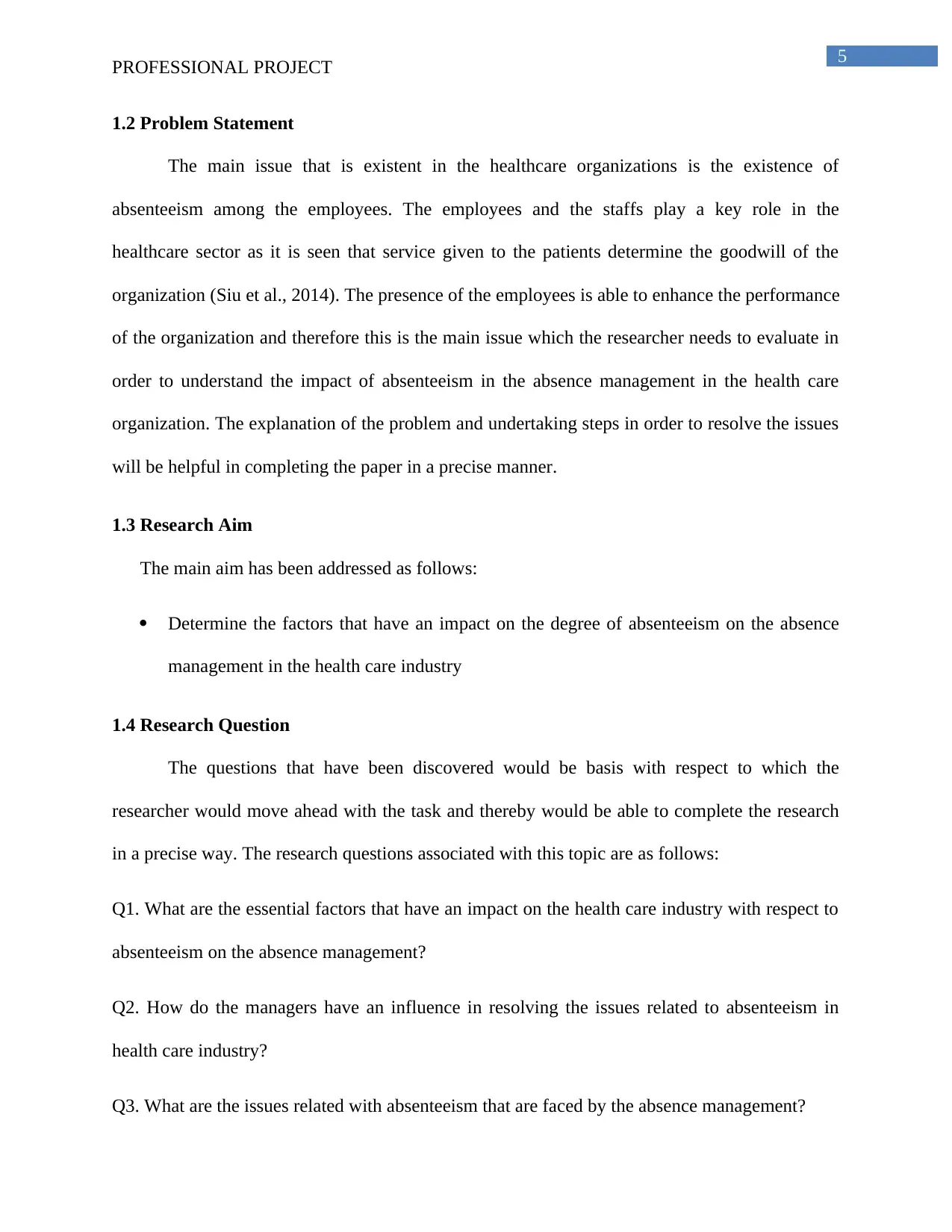
5
PROFESSIONAL PROJECT
1.2 Problem Statement
The main issue that is existent in the healthcare organizations is the existence of
absenteeism among the employees. The employees and the staffs play a key role in the
healthcare sector as it is seen that service given to the patients determine the goodwill of the
organization (Siu et al., 2014). The presence of the employees is able to enhance the performance
of the organization and therefore this is the main issue which the researcher needs to evaluate in
order to understand the impact of absenteeism in the absence management in the health care
organization. The explanation of the problem and undertaking steps in order to resolve the issues
will be helpful in completing the paper in a precise manner.
1.3 Research Aim
The main aim has been addressed as follows:
Determine the factors that have an impact on the degree of absenteeism on the absence
management in the health care industry
1.4 Research Question
The questions that have been discovered would be basis with respect to which the
researcher would move ahead with the task and thereby would be able to complete the research
in a precise way. The research questions associated with this topic are as follows:
Q1. What are the essential factors that have an impact on the health care industry with respect to
absenteeism on the absence management?
Q2. How do the managers have an influence in resolving the issues related to absenteeism in
health care industry?
Q3. What are the issues related with absenteeism that are faced by the absence management?
PROFESSIONAL PROJECT
1.2 Problem Statement
The main issue that is existent in the healthcare organizations is the existence of
absenteeism among the employees. The employees and the staffs play a key role in the
healthcare sector as it is seen that service given to the patients determine the goodwill of the
organization (Siu et al., 2014). The presence of the employees is able to enhance the performance
of the organization and therefore this is the main issue which the researcher needs to evaluate in
order to understand the impact of absenteeism in the absence management in the health care
organization. The explanation of the problem and undertaking steps in order to resolve the issues
will be helpful in completing the paper in a precise manner.
1.3 Research Aim
The main aim has been addressed as follows:
Determine the factors that have an impact on the degree of absenteeism on the absence
management in the health care industry
1.4 Research Question
The questions that have been discovered would be basis with respect to which the
researcher would move ahead with the task and thereby would be able to complete the research
in a precise way. The research questions associated with this topic are as follows:
Q1. What are the essential factors that have an impact on the health care industry with respect to
absenteeism on the absence management?
Q2. How do the managers have an influence in resolving the issues related to absenteeism in
health care industry?
Q3. What are the issues related with absenteeism that are faced by the absence management?
⊘ This is a preview!⊘
Do you want full access?
Subscribe today to unlock all pages.

Trusted by 1+ million students worldwide
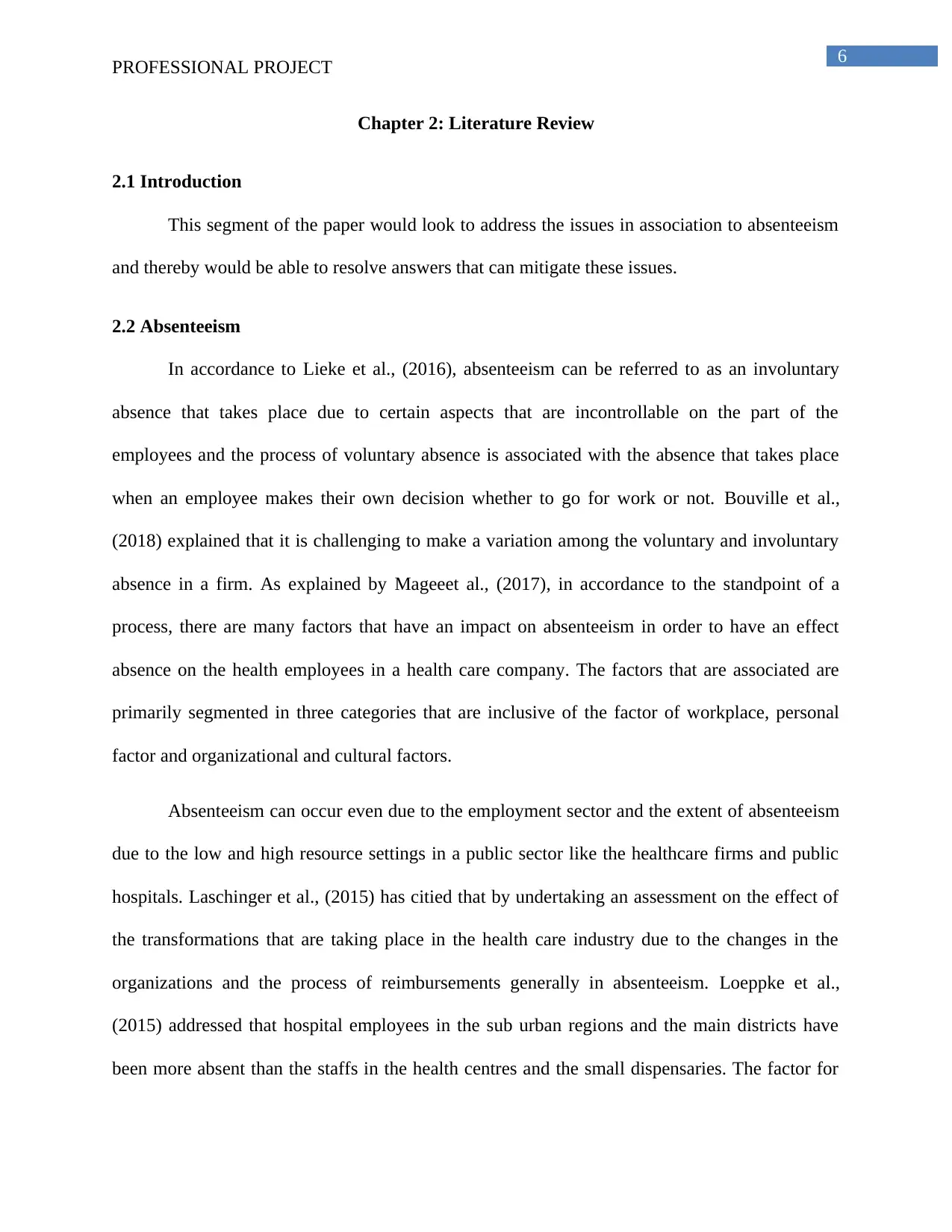
6
PROFESSIONAL PROJECT
Chapter 2: Literature Review
2.1 Introduction
This segment of the paper would look to address the issues in association to absenteeism
and thereby would be able to resolve answers that can mitigate these issues.
2.2 Absenteeism
In accordance to Lieke et al., (2016), absenteeism can be referred to as an involuntary
absence that takes place due to certain aspects that are incontrollable on the part of the
employees and the process of voluntary absence is associated with the absence that takes place
when an employee makes their own decision whether to go for work or not. Bouville et al.,
(2018) explained that it is challenging to make a variation among the voluntary and involuntary
absence in a firm. As explained by Mageeet al., (2017), in accordance to the standpoint of a
process, there are many factors that have an impact on absenteeism in order to have an effect
absence on the health employees in a health care company. The factors that are associated are
primarily segmented in three categories that are inclusive of the factor of workplace, personal
factor and organizational and cultural factors.
Absenteeism can occur even due to the employment sector and the extent of absenteeism
due to the low and high resource settings in a public sector like the healthcare firms and public
hospitals. Laschinger et al., (2015) has citied that by undertaking an assessment on the effect of
the transformations that are taking place in the health care industry due to the changes in the
organizations and the process of reimbursements generally in absenteeism. Loeppke et al.,
(2015) addressed that hospital employees in the sub urban regions and the main districts have
been more absent than the staffs in the health centres and the small dispensaries. The factor for
PROFESSIONAL PROJECT
Chapter 2: Literature Review
2.1 Introduction
This segment of the paper would look to address the issues in association to absenteeism
and thereby would be able to resolve answers that can mitigate these issues.
2.2 Absenteeism
In accordance to Lieke et al., (2016), absenteeism can be referred to as an involuntary
absence that takes place due to certain aspects that are incontrollable on the part of the
employees and the process of voluntary absence is associated with the absence that takes place
when an employee makes their own decision whether to go for work or not. Bouville et al.,
(2018) explained that it is challenging to make a variation among the voluntary and involuntary
absence in a firm. As explained by Mageeet al., (2017), in accordance to the standpoint of a
process, there are many factors that have an impact on absenteeism in order to have an effect
absence on the health employees in a health care company. The factors that are associated are
primarily segmented in three categories that are inclusive of the factor of workplace, personal
factor and organizational and cultural factors.
Absenteeism can occur even due to the employment sector and the extent of absenteeism
due to the low and high resource settings in a public sector like the healthcare firms and public
hospitals. Laschinger et al., (2015) has citied that by undertaking an assessment on the effect of
the transformations that are taking place in the health care industry due to the changes in the
organizations and the process of reimbursements generally in absenteeism. Loeppke et al.,
(2015) addressed that hospital employees in the sub urban regions and the main districts have
been more absent than the staffs in the health centres and the small dispensaries. The factor for
Paraphrase This Document
Need a fresh take? Get an instant paraphrase of this document with our AI Paraphraser
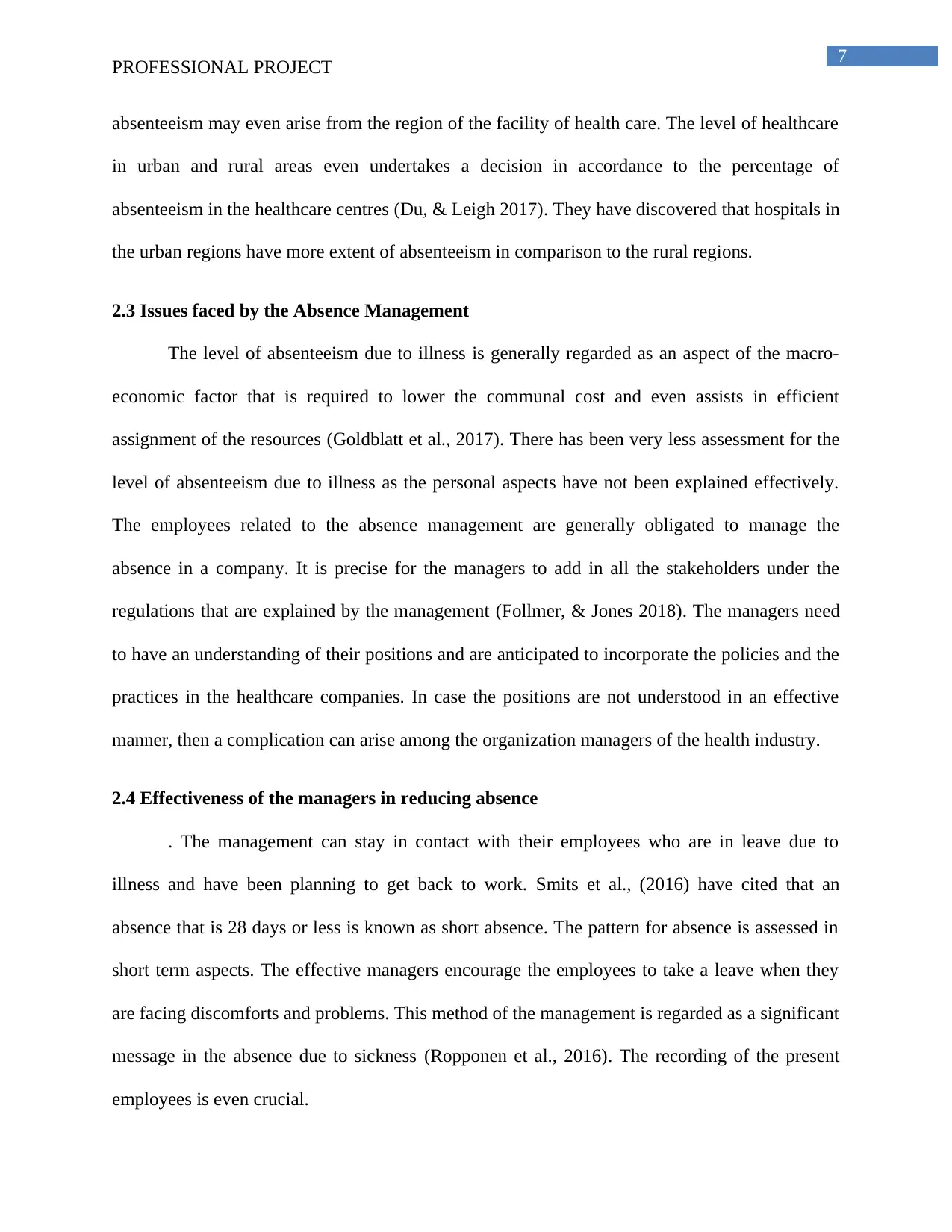
7
PROFESSIONAL PROJECT
absenteeism may even arise from the region of the facility of health care. The level of healthcare
in urban and rural areas even undertakes a decision in accordance to the percentage of
absenteeism in the healthcare centres (Du, & Leigh 2017). They have discovered that hospitals in
the urban regions have more extent of absenteeism in comparison to the rural regions.
2.3 Issues faced by the Absence Management
The level of absenteeism due to illness is generally regarded as an aspect of the macro-
economic factor that is required to lower the communal cost and even assists in efficient
assignment of the resources (Goldblatt et al., 2017). There has been very less assessment for the
level of absenteeism due to illness as the personal aspects have not been explained effectively.
The employees related to the absence management are generally obligated to manage the
absence in a company. It is precise for the managers to add in all the stakeholders under the
regulations that are explained by the management (Follmer, & Jones 2018). The managers need
to have an understanding of their positions and are anticipated to incorporate the policies and the
practices in the healthcare companies. In case the positions are not understood in an effective
manner, then a complication can arise among the organization managers of the health industry.
2.4 Effectiveness of the managers in reducing absence
. The management can stay in contact with their employees who are in leave due to
illness and have been planning to get back to work. Smits et al., (2016) have cited that an
absence that is 28 days or less is known as short absence. The pattern for absence is assessed in
short term aspects. The effective managers encourage the employees to take a leave when they
are facing discomforts and problems. This method of the management is regarded as a significant
message in the absence due to sickness (Ropponen et al., 2016). The recording of the present
employees is even crucial.
PROFESSIONAL PROJECT
absenteeism may even arise from the region of the facility of health care. The level of healthcare
in urban and rural areas even undertakes a decision in accordance to the percentage of
absenteeism in the healthcare centres (Du, & Leigh 2017). They have discovered that hospitals in
the urban regions have more extent of absenteeism in comparison to the rural regions.
2.3 Issues faced by the Absence Management
The level of absenteeism due to illness is generally regarded as an aspect of the macro-
economic factor that is required to lower the communal cost and even assists in efficient
assignment of the resources (Goldblatt et al., 2017). There has been very less assessment for the
level of absenteeism due to illness as the personal aspects have not been explained effectively.
The employees related to the absence management are generally obligated to manage the
absence in a company. It is precise for the managers to add in all the stakeholders under the
regulations that are explained by the management (Follmer, & Jones 2018). The managers need
to have an understanding of their positions and are anticipated to incorporate the policies and the
practices in the healthcare companies. In case the positions are not understood in an effective
manner, then a complication can arise among the organization managers of the health industry.
2.4 Effectiveness of the managers in reducing absence
. The management can stay in contact with their employees who are in leave due to
illness and have been planning to get back to work. Smits et al., (2016) have cited that an
absence that is 28 days or less is known as short absence. The pattern for absence is assessed in
short term aspects. The effective managers encourage the employees to take a leave when they
are facing discomforts and problems. This method of the management is regarded as a significant
message in the absence due to sickness (Ropponen et al., 2016). The recording of the present
employees is even crucial.
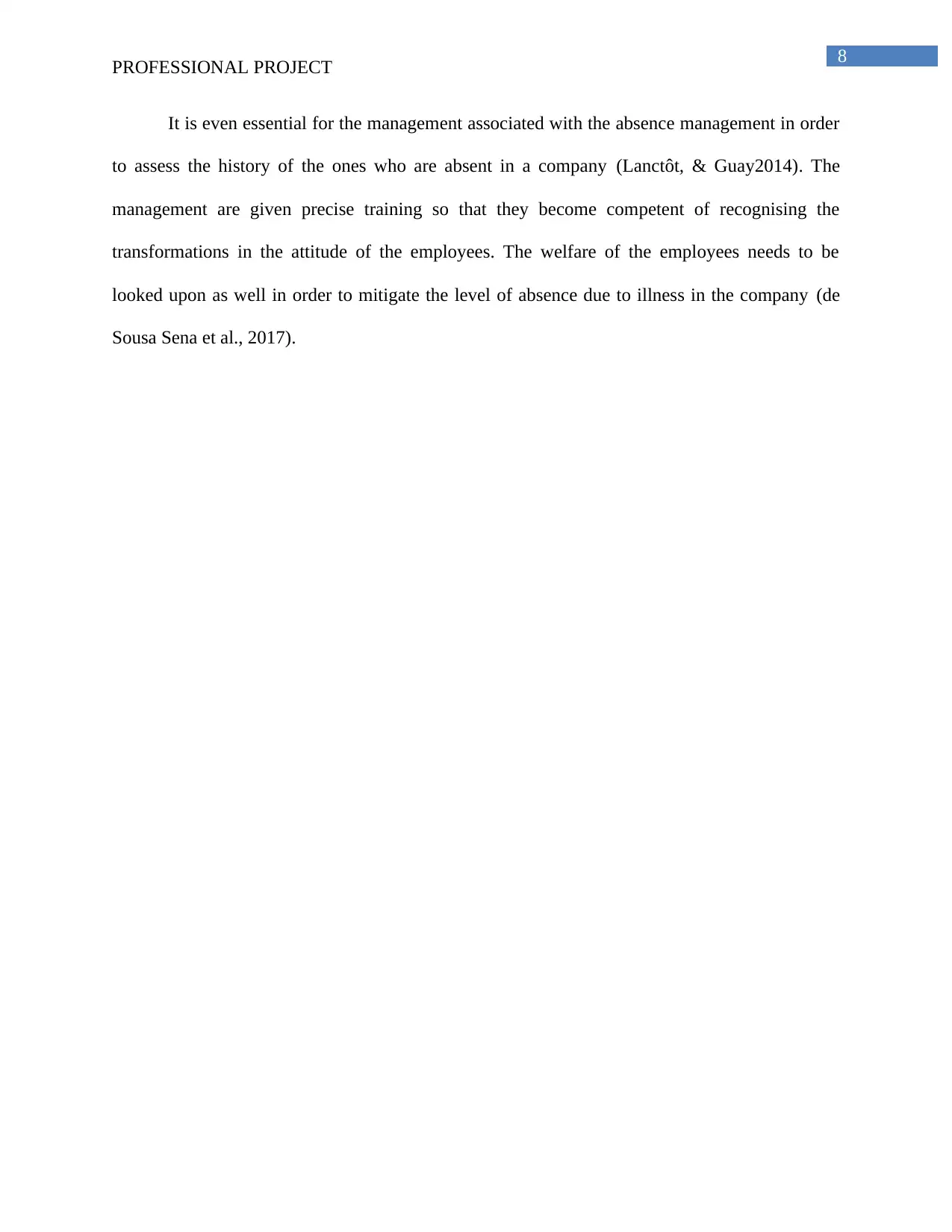
8
PROFESSIONAL PROJECT
It is even essential for the management associated with the absence management in order
to assess the history of the ones who are absent in a company (Lanctôt, & Guay2014). The
management are given precise training so that they become competent of recognising the
transformations in the attitude of the employees. The welfare of the employees needs to be
looked upon as well in order to mitigate the level of absence due to illness in the company (de
Sousa Sena et al., 2017).
PROFESSIONAL PROJECT
It is even essential for the management associated with the absence management in order
to assess the history of the ones who are absent in a company (Lanctôt, & Guay2014). The
management are given precise training so that they become competent of recognising the
transformations in the attitude of the employees. The welfare of the employees needs to be
looked upon as well in order to mitigate the level of absence due to illness in the company (de
Sousa Sena et al., 2017).
⊘ This is a preview!⊘
Do you want full access?
Subscribe today to unlock all pages.

Trusted by 1+ million students worldwide
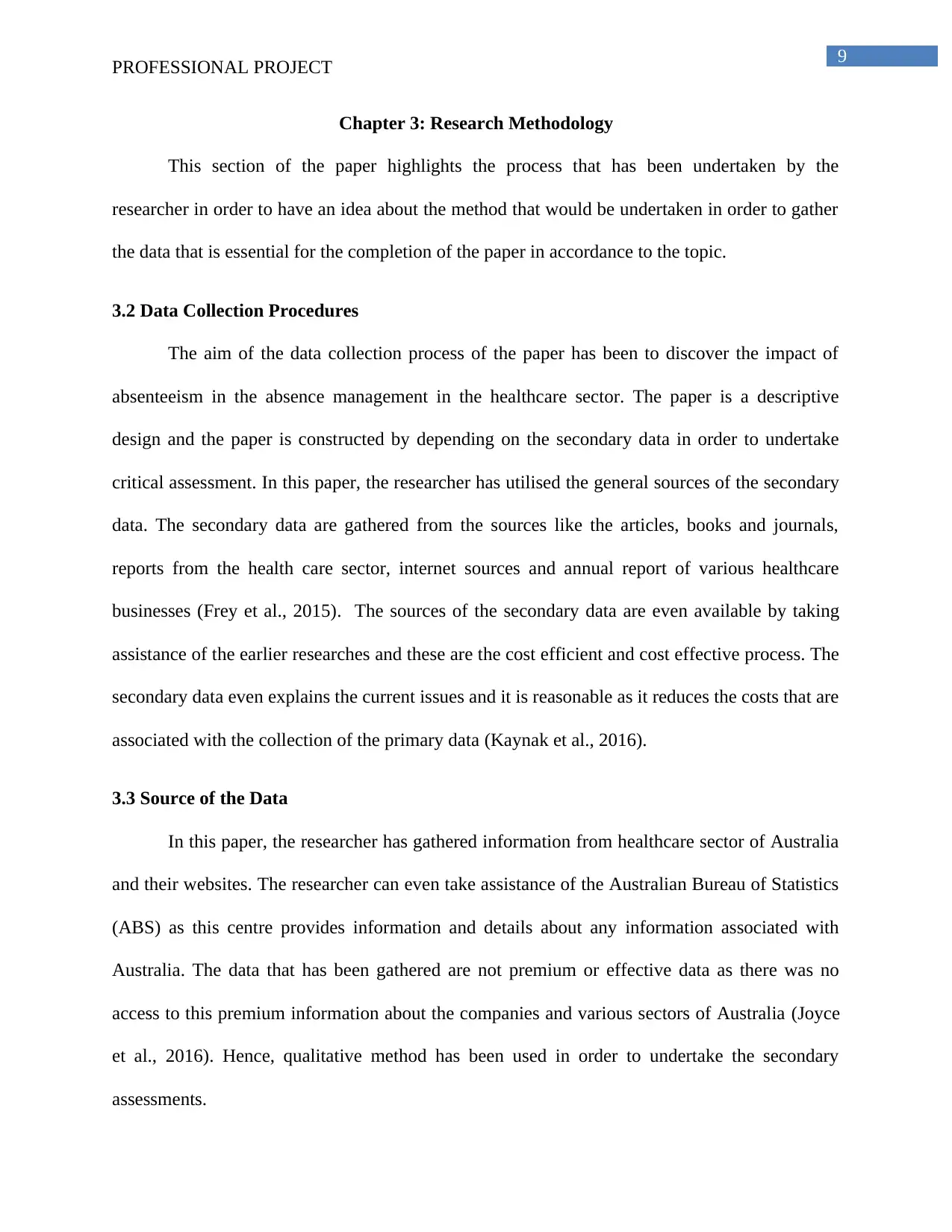
9
PROFESSIONAL PROJECT
Chapter 3: Research Methodology
This section of the paper highlights the process that has been undertaken by the
researcher in order to have an idea about the method that would be undertaken in order to gather
the data that is essential for the completion of the paper in accordance to the topic.
3.2 Data Collection Procedures
The aim of the data collection process of the paper has been to discover the impact of
absenteeism in the absence management in the healthcare sector. The paper is a descriptive
design and the paper is constructed by depending on the secondary data in order to undertake
critical assessment. In this paper, the researcher has utilised the general sources of the secondary
data. The secondary data are gathered from the sources like the articles, books and journals,
reports from the health care sector, internet sources and annual report of various healthcare
businesses (Frey et al., 2015). The sources of the secondary data are even available by taking
assistance of the earlier researches and these are the cost efficient and cost effective process. The
secondary data even explains the current issues and it is reasonable as it reduces the costs that are
associated with the collection of the primary data (Kaynak et al., 2016).
3.3 Source of the Data
In this paper, the researcher has gathered information from healthcare sector of Australia
and their websites. The researcher can even take assistance of the Australian Bureau of Statistics
(ABS) as this centre provides information and details about any information associated with
Australia. The data that has been gathered are not premium or effective data as there was no
access to this premium information about the companies and various sectors of Australia (Joyce
et al., 2016). Hence, qualitative method has been used in order to undertake the secondary
assessments.
PROFESSIONAL PROJECT
Chapter 3: Research Methodology
This section of the paper highlights the process that has been undertaken by the
researcher in order to have an idea about the method that would be undertaken in order to gather
the data that is essential for the completion of the paper in accordance to the topic.
3.2 Data Collection Procedures
The aim of the data collection process of the paper has been to discover the impact of
absenteeism in the absence management in the healthcare sector. The paper is a descriptive
design and the paper is constructed by depending on the secondary data in order to undertake
critical assessment. In this paper, the researcher has utilised the general sources of the secondary
data. The secondary data are gathered from the sources like the articles, books and journals,
reports from the health care sector, internet sources and annual report of various healthcare
businesses (Frey et al., 2015). The sources of the secondary data are even available by taking
assistance of the earlier researches and these are the cost efficient and cost effective process. The
secondary data even explains the current issues and it is reasonable as it reduces the costs that are
associated with the collection of the primary data (Kaynak et al., 2016).
3.3 Source of the Data
In this paper, the researcher has gathered information from healthcare sector of Australia
and their websites. The researcher can even take assistance of the Australian Bureau of Statistics
(ABS) as this centre provides information and details about any information associated with
Australia. The data that has been gathered are not premium or effective data as there was no
access to this premium information about the companies and various sectors of Australia (Joyce
et al., 2016). Hence, qualitative method has been used in order to undertake the secondary
assessments.
Paraphrase This Document
Need a fresh take? Get an instant paraphrase of this document with our AI Paraphraser
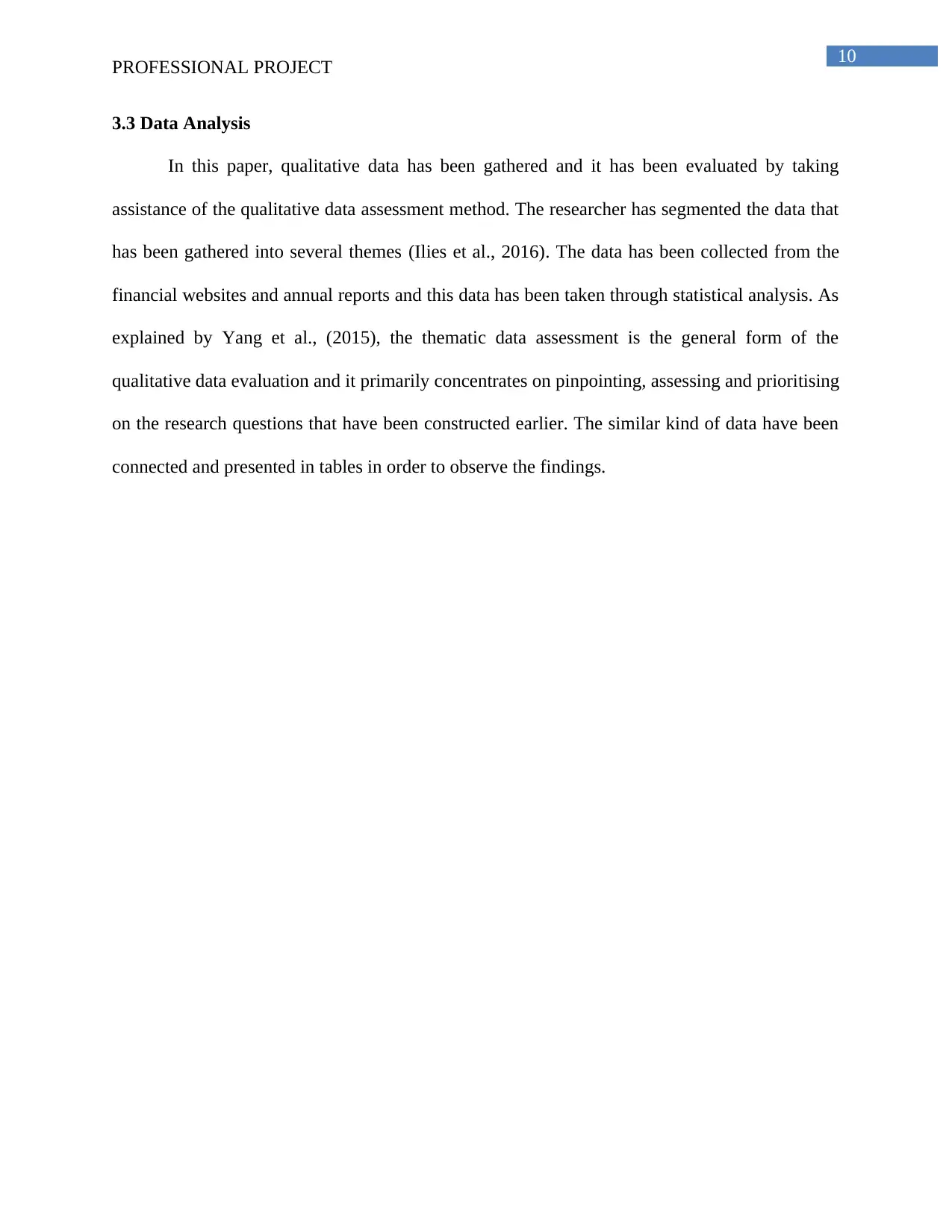
10
PROFESSIONAL PROJECT
3.3 Data Analysis
In this paper, qualitative data has been gathered and it has been evaluated by taking
assistance of the qualitative data assessment method. The researcher has segmented the data that
has been gathered into several themes (Ilies et al., 2016). The data has been collected from the
financial websites and annual reports and this data has been taken through statistical analysis. As
explained by Yang et al., (2015), the thematic data assessment is the general form of the
qualitative data evaluation and it primarily concentrates on pinpointing, assessing and prioritising
on the research questions that have been constructed earlier. The similar kind of data have been
connected and presented in tables in order to observe the findings.
PROFESSIONAL PROJECT
3.3 Data Analysis
In this paper, qualitative data has been gathered and it has been evaluated by taking
assistance of the qualitative data assessment method. The researcher has segmented the data that
has been gathered into several themes (Ilies et al., 2016). The data has been collected from the
financial websites and annual reports and this data has been taken through statistical analysis. As
explained by Yang et al., (2015), the thematic data assessment is the general form of the
qualitative data evaluation and it primarily concentrates on pinpointing, assessing and prioritising
on the research questions that have been constructed earlier. The similar kind of data have been
connected and presented in tables in order to observe the findings.
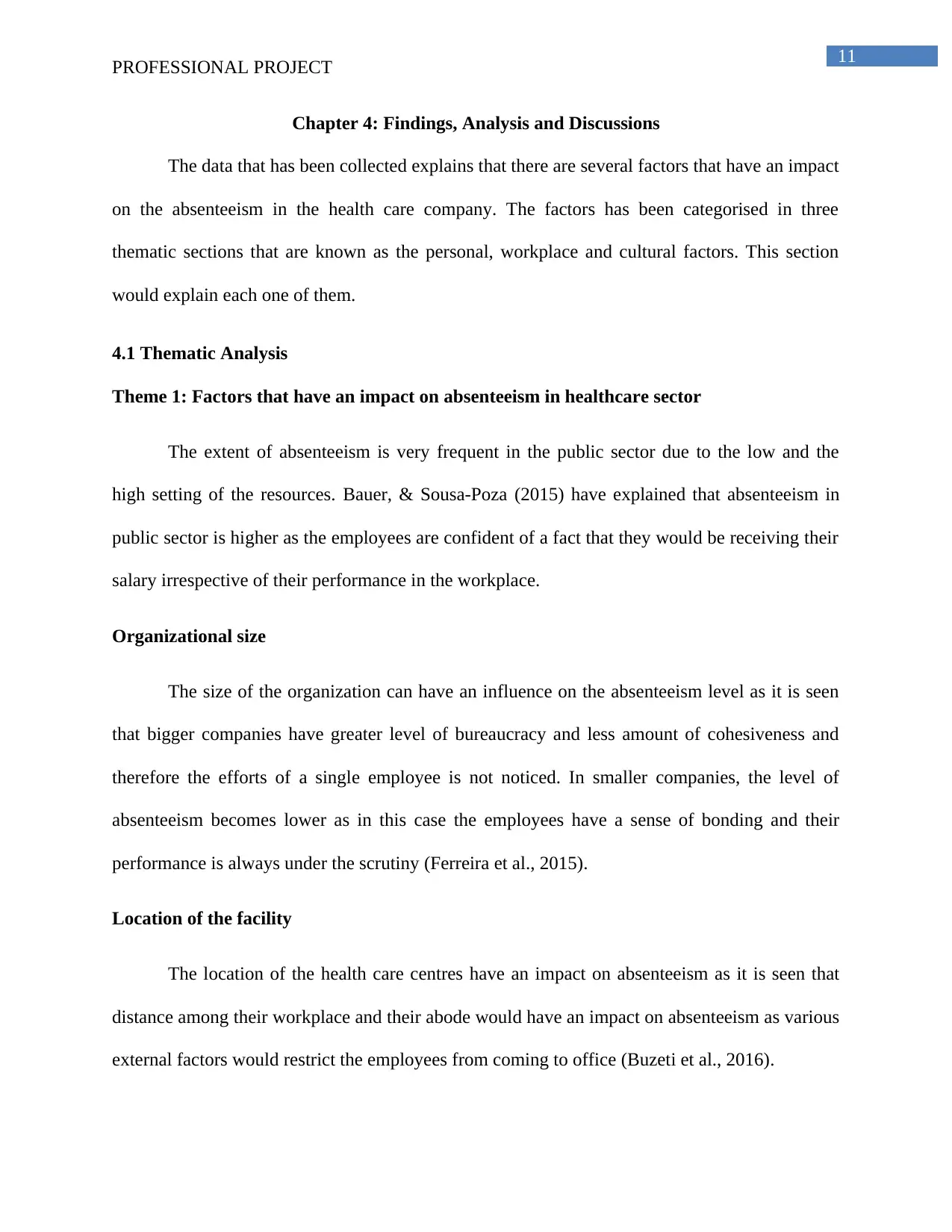
11
PROFESSIONAL PROJECT
Chapter 4: Findings, Analysis and Discussions
The data that has been collected explains that there are several factors that have an impact
on the absenteeism in the health care company. The factors has been categorised in three
thematic sections that are known as the personal, workplace and cultural factors. This section
would explain each one of them.
4.1 Thematic Analysis
Theme 1: Factors that have an impact on absenteeism in healthcare sector
The extent of absenteeism is very frequent in the public sector due to the low and the
high setting of the resources. Bauer, & Sousa-Poza (2015) have explained that absenteeism in
public sector is higher as the employees are confident of a fact that they would be receiving their
salary irrespective of their performance in the workplace.
Organizational size
The size of the organization can have an influence on the absenteeism level as it is seen
that bigger companies have greater level of bureaucracy and less amount of cohesiveness and
therefore the efforts of a single employee is not noticed. In smaller companies, the level of
absenteeism becomes lower as in this case the employees have a sense of bonding and their
performance is always under the scrutiny (Ferreira et al., 2015).
Location of the facility
The location of the health care centres have an impact on absenteeism as it is seen that
distance among their workplace and their abode would have an impact on absenteeism as various
external factors would restrict the employees from coming to office (Buzeti et al., 2016).
PROFESSIONAL PROJECT
Chapter 4: Findings, Analysis and Discussions
The data that has been collected explains that there are several factors that have an impact
on the absenteeism in the health care company. The factors has been categorised in three
thematic sections that are known as the personal, workplace and cultural factors. This section
would explain each one of them.
4.1 Thematic Analysis
Theme 1: Factors that have an impact on absenteeism in healthcare sector
The extent of absenteeism is very frequent in the public sector due to the low and the
high setting of the resources. Bauer, & Sousa-Poza (2015) have explained that absenteeism in
public sector is higher as the employees are confident of a fact that they would be receiving their
salary irrespective of their performance in the workplace.
Organizational size
The size of the organization can have an influence on the absenteeism level as it is seen
that bigger companies have greater level of bureaucracy and less amount of cohesiveness and
therefore the efforts of a single employee is not noticed. In smaller companies, the level of
absenteeism becomes lower as in this case the employees have a sense of bonding and their
performance is always under the scrutiny (Ferreira et al., 2015).
Location of the facility
The location of the health care centres have an impact on absenteeism as it is seen that
distance among their workplace and their abode would have an impact on absenteeism as various
external factors would restrict the employees from coming to office (Buzeti et al., 2016).
⊘ This is a preview!⊘
Do you want full access?
Subscribe today to unlock all pages.

Trusted by 1+ million students worldwide
1 out of 29
Related Documents
Your All-in-One AI-Powered Toolkit for Academic Success.
+13062052269
info@desklib.com
Available 24*7 on WhatsApp / Email
![[object Object]](/_next/static/media/star-bottom.7253800d.svg)
Unlock your academic potential
Copyright © 2020–2025 A2Z Services. All Rights Reserved. Developed and managed by ZUCOL.





